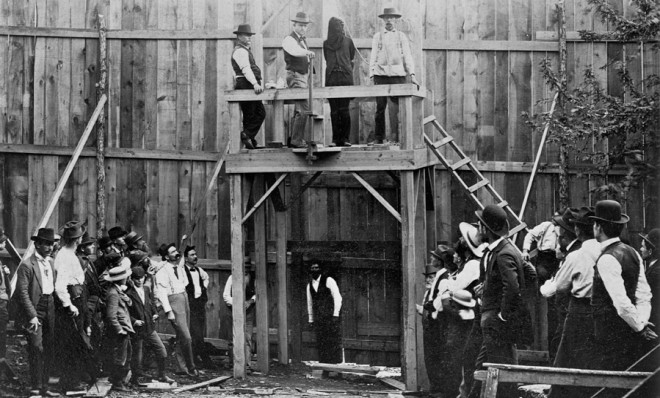6 people who survived their own executions
Being hanged by incompetent executioners can be a blessing in disguise


The belief that a person who survives execution cannot legally be executed again is, for the most part, a myth. That is why the pronouncement of many death sentences ends with the words "until dead." That means whatever it takes, however long it takes, you're riding this train to your final destination.
But it wasn't always that way. In the past, people who survived judicial executions often did escape with their lives. It was often seen as an act of God and a declaration of innocence. Sometimes it was just considered shoddy work. Below are some examples of people who survived their own executions — even if only for a while:
1. The Man Franks
The Week
Escape your echo chamber. Get the facts behind the news, plus analysis from multiple perspectives.

Sign up for The Week's Free Newsletters
From our morning news briefing to a weekly Good News Newsletter, get the best of The Week delivered directly to your inbox.
From our morning news briefing to a weekly Good News Newsletter, get the best of The Week delivered directly to your inbox.
A murderer, recorded as "The Man Franks" in an 1872 copy of an Australian paper, survived his execution thanks to his executioners' great incompetence. He also had the unfortunate distinction of being the first person to be executed in the briefly established Kingdom of Fiji (within two years, debt would drive Fiji to become a colony of Britain).
The executioners didn't know what they were doing, and the execution took place hours after it was scheduled because the sheriff didn't find the established time convenient. The rope they'd set out got wet in the rain, and had to be held over a fire to dry. Then:
Before slipping the noose over the wretched man's head, the hangman had to sit down and place one of his feet in and pull with all his might to make the knot run; then after placing it over Franks' head he had the utmost difficulty in making it fit anything like tight, but not nearly so tight as it should have been.
Franks dropped, but after three minutes of silence started moving and talking, asking to be put out of his misery. Since his hands were improperly tied, he managed to reach up and pull the rope from his throat, forgiving those around him for the "black job" they'd made of his execution. Finally an official cut Franks down. He landed with a thud, as no one had thought to ease him to the ground.
After watching such a spectacle, no one wanted to go through it again, and Franks was spared death. The officials and citizens preferred his banishment, and the power of the new Fijian monarchy was made a laughingstock to the world.
A free daily email with the biggest news stories of the day – and the best features from TheWeek.com
2. Anne Greene
In 1650, when Anne Greene was 22, she was a servant in the household of Sir Thomas Read. She became pregnant by his grandson, though she claimed she did not know she was with child. At 18 weeks, while churning malt, Anne felt sick. In the privy she miscarried, and in her terror, hid the baby in some ashes and dirt.
There existed a statute at the time that any single woman who concealed a pregnancy or stillbirth could be accused of infanticide. Though midwives asserted the fetus was too young to have ever lived, Greene was hanged in the courtyard of Oxford castle. Her last words were to condemn the "lewdness of the family wherein she lately lived." She had requested her friends pull at her body to hasten her demise, and they did. The body was cut down and delivered to a medical school for dissection. However, when the coffin was opened, the surgeons detected a faint rise and fall of Anne's chest. They forgot their original intention and began to try and revive her — through bleeding, having cordial forced down her throat, and hot plasters, which she also survived.
The public saw this as the decision of a just God, and Greene was pardoned. Taking her coffin as a souvenir, she settled in another town, married, and had children. Her father thought to charge admission to meet her, and the money settled all her medical and legal debts.
3. Half-Hangit Maggie
Maggie Dickson got pregnant while her husband was away at sea, which was a very unfortunate situation for a woman in 1724. She tried to conceal the pregnancy (which, remember, was illegal) but no one in her boardinghouse was buying it. Depending on who you ask, the premature baby was or was not stillborn. But it didn't really matter, since Dickson had concealed it. She was executed by hanging. Her family was able to claim the body and keep it from the dissection table. As they drove Maggie in her coffin toward the cemetery, they stopped when they heard someone tapping on the inside of the coffin. Maggie's survival was taken as an act of God. She became a celebrity, nicknamed Half-Hangit Maggie. She lived another 40 years, and today a tavern stands in her honor near the site of her hanging.
4. Inetta de Balsham
Inetta de Balsham was sentenced to death for harboring thieves in 1264. The records claim that she was hanged at 9 a.m. on Monday, August 16, and left on the gallows until the following Thursday morning. When she was cut down, it is claimed she was still alive. Her windpipe was described as "deformed and ossified," and so was never sufficiently compressed by the noose. Her survival brought her to the attention of King Henry III, who granted her a royal pardon.
5. Romell Broom
To survive a modern execution is truly a miracle. Deaths by lethal injection are designed to dispatch the convicted quickly, painlessly, and without error. Romell Broom proved that isn't what always happens.
In 2009, Romell, convicted of kidnapping, rape, and murder, became the first person to survive an execution by lethal injection. The executioners tried for two hours to find a suitable vein for an IV line, hitting bone and muscle in the process, but never piercing a vein that didn't immediately collapse. Finally, he was sent back to his cell and granted a week's reprieve. During that reprieve, Romell's lawyers declared he had suffered cruel and unusual punishment during his unsuccessful execution. They began a larger movement to change the lethal injection laws in the United States, and declared that to kill Romell would be to destroy key evidence in the suit. He is still alive, and waiting on appeal.
6. Ewan Macdonald
In 1752, Ewan Macdonald got into an argument with Robert Parker. When Parker tried to leave, Macdonald followed him and stabbed him in the throat. Macdonald was found guilty of murder and hanged on the town moor in Newcastle, England. His body went where most of the bodies of executed criminals went at that time: To the dissection theater of a local medical school. These corpses were very valuable to the surgeons, as they were the only legal way to study anatomy. Perhaps that explains why, upon entering the theater and finding a dazed Macdonald sitting up on the operating table, the dissecting surgeon grabbed a mallet, struck Macdonald's head, and finished the hangman's job. It is said that divine retribution was delivered years later, when the same surgeon died from a kick in the head by his own horse.
Therese O'Neill lives in Oregon and writes for The Atlantic, Mental Floss, Jezebel, and more. She is the author of New York Times bestseller Unmentionable: The Victorian Ladies Guide to Sex, Marriage and Manners. Meet her at writerthereseoneill.com.
-
 ‘Care fractures after birth’
‘Care fractures after birth’instant opinion Opinion, comment and editorials of the day
-
 Shots fired in the US-EU war over digital censorship
Shots fired in the US-EU war over digital censorshipIN THE SPOTLIGHT The Trump administration risks opening a dangerous new front in the battle of real-world consequences for online action
-
 What will the US economy look like in 2026?
What will the US economy look like in 2026?Today’s Big Question Wall Street is bullish, but uncertain
